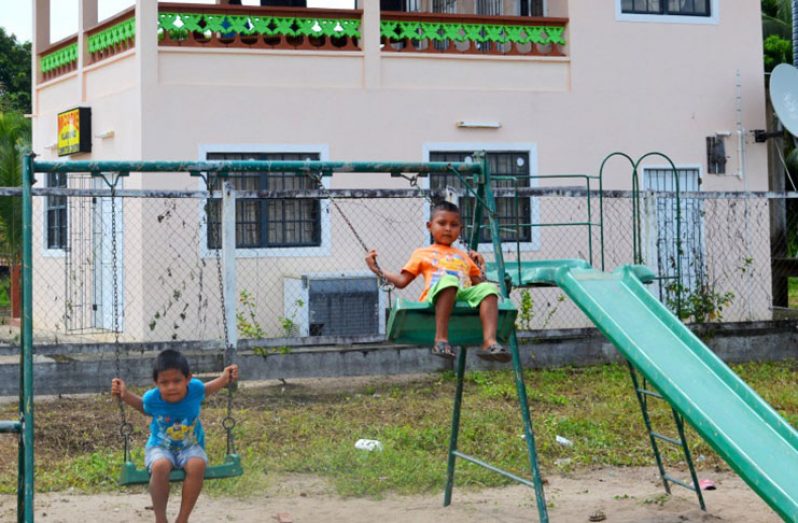— calls made for testing of mercury levels in residents
IN 2010, a study done by Canadian scientists at the village of Micobie in Region Eight, concluded that the mercury levels in persons at the riverside village had dropped from 21.3 mg (milligrammes) to 10 mg over a decade-long period.
While it is unclear if tests were subsequently carried out there, the village is today concerned that the substance may be behind the deformities in six children there, some of whom were born after the 2010 study.
Mercury is used in the gold-mining industry and can be a threat to human health and the environment.
According to the World Health Organisation (WHO), the substance is toxic to human health, posing a particular threat to the development of the child in utero and early in life.
Human beings are expected to have a normal level of 10mg of the substance in their bodies.
The 2010 study was done in several villages in the country’s hinterland, including at Micobie and it focused mainly on pregnant and lactating women.
Methyl mercury, a form of the substance, is of special concern for foetuses, infants and children, because it impairs the development of their brains and nervous systems.
When a woman eats fish contaminated with mercury it accumulates in her body, requiring several years to excrete. If she becomes pregnant within that time, her foetus will be exposed to methyl mercury in the womb and this will affect the foetus’s growing brain and nervous system.
Head of the Guyana Environmental Management and Capacity Development Programme (GENCAPD), Dr Richard Couture, said at the time that the survey was based on the premise that there was an increased presence of mercury at mining areas in Guyana. The study recommended that the villagers use less fish, a main contaminant of the substance.
ANXIOUS
During a visit to Micobie last Sunday, the Village Council was anxious to find out whether the health authorities can undertake another study there soon.
Toshao John Andre noted that such a test is needed, since the residents of the small Patamona indigenous village had their suspicions about the substance being tied to the deformities of the children.
“If was something from their foreparents, we would know that it passed down but this is not from the family line,” he said.
Farming and small-scale gold mining are the main economic activities at the village and like most indigenous communities, residents have no other alternatives for protein other than fish.
Andre said most persons would travel up the Potaro River near the Tumatumari Falls to catch fish.
“You see when they [authorities] do tests, they don’t give us back the actual results, but they recommend that we don’t eat certain types of fish,” Andre said.
He said the villagers needed more clarity on the issue, such as what types of fish they should or should not eat. In addition, he noted that the test results would help the council to educate the residents on the substance and its effects on their bodies.
“They took samples from everyone,” Majuna Edwards, one of the participants of the 2010 study, said.
“Since the children born we noticed they were not normal,” Edwards noted of the children who were born differently-abled.
She said one of the children is unable to walk, and as such, a wheelchair was recently donated to the village to assist him.
Residents of another interior village who participated in the 2010 study also shared a similar opinion.
Women of Isseneru, an indigenous village in the Middle Mazaruni, also had high levels of mercury in their systems and one resident noted that the issue was alarming.
In the years prior to the 2010 survey, the respondents at Isseneru had an average of 18.3 mg of mercury in their bodies. The figure dropped to 10 mg following the study and recommendations by GENCAPD.
PREVIOUS CALL
In 2013, the village had called for another study to be done, since residents believed mercury levels in their bodies were high.
On Wednesday, August 16 this year, the Minamata Convention on Mercury came into force. The Convention is an international treaty designed to protect human health and the environment from anthropogenic emissions and releases of mercury and mercury compounds.
The Guyana Government signed on to the Minamata Convention on October 10, 2013 and ratified it on September 24, 2014, one of the first nations to ratify the treaty.
It received full support of the mining sector here, mainly members of the Guyana Gold and Diamond Miners Association (GGDMA) and the Guyana Women Miners’ Organisation (GWMO), following consultations.
Last year, this newspaper reported that mining has been said to be the cause of ailments in children of the hinterland. There has been no study to ascertain the cause(s) of cancer in these parts of Guyana; however, Dr Latoya Gooding, who was treating children with cancerous ailments at the Georgetown Public Hospital Corporation (GPHC), opined that pollution of waterways due to mining may be a primary cause.
While the Guyana Geology and Mines Commission (GGMC) has been piloting a number of mercury-free technologies in the fields, the Micobie Village Council believes that stringent recommendations regarding the use of mercury in the mining sector should be implemented, not only at their village, but elsewhere across the country’s mining districts.
The Guyana Chronicle reported last month that the Government recently engaged Conservation International Guyana on the Eldorado Gold Mining Initiative to advance green development of the mining sector by focusing on phasing out mercury use, by engaging actors within the gold-mining supply chain.
Guyana is expected to field a delegation at the first Conference of the Parties to the Minamata Convention to be held from September 24 – 29, 2017 in Geneva, Switzerland.




.png)









